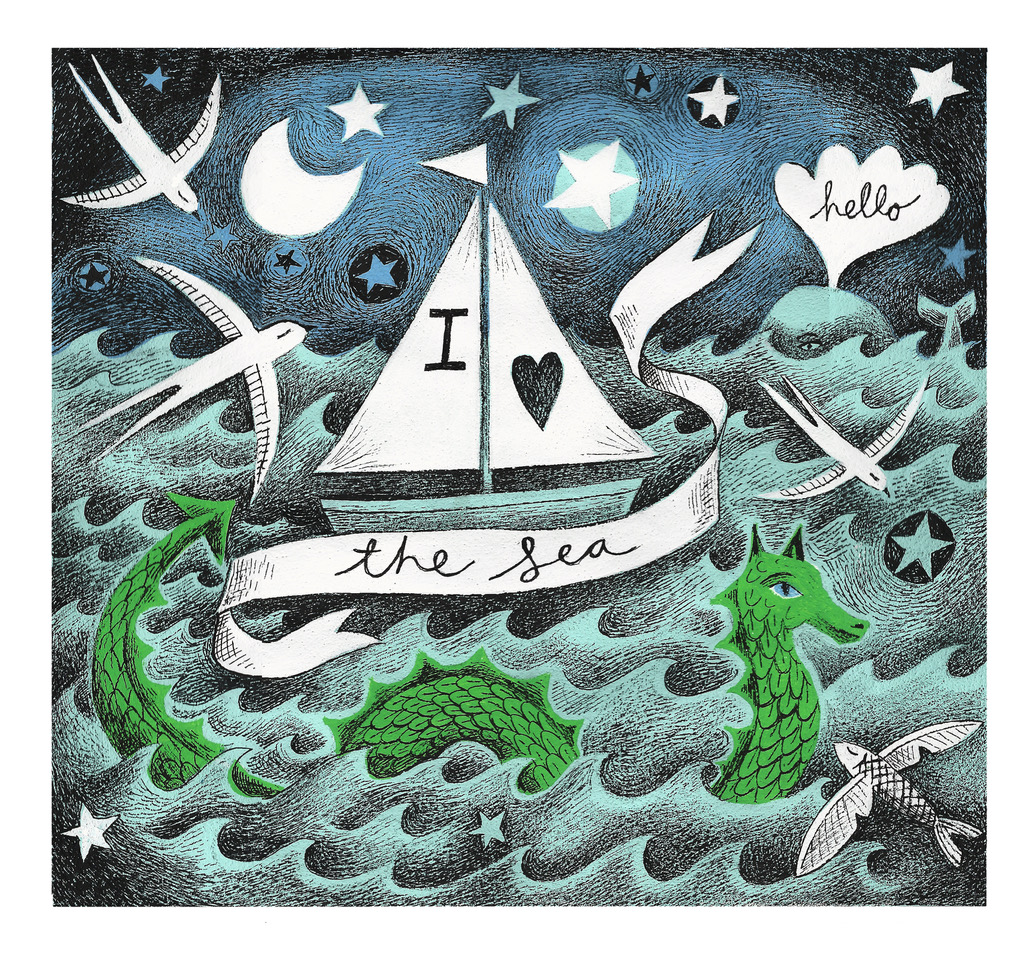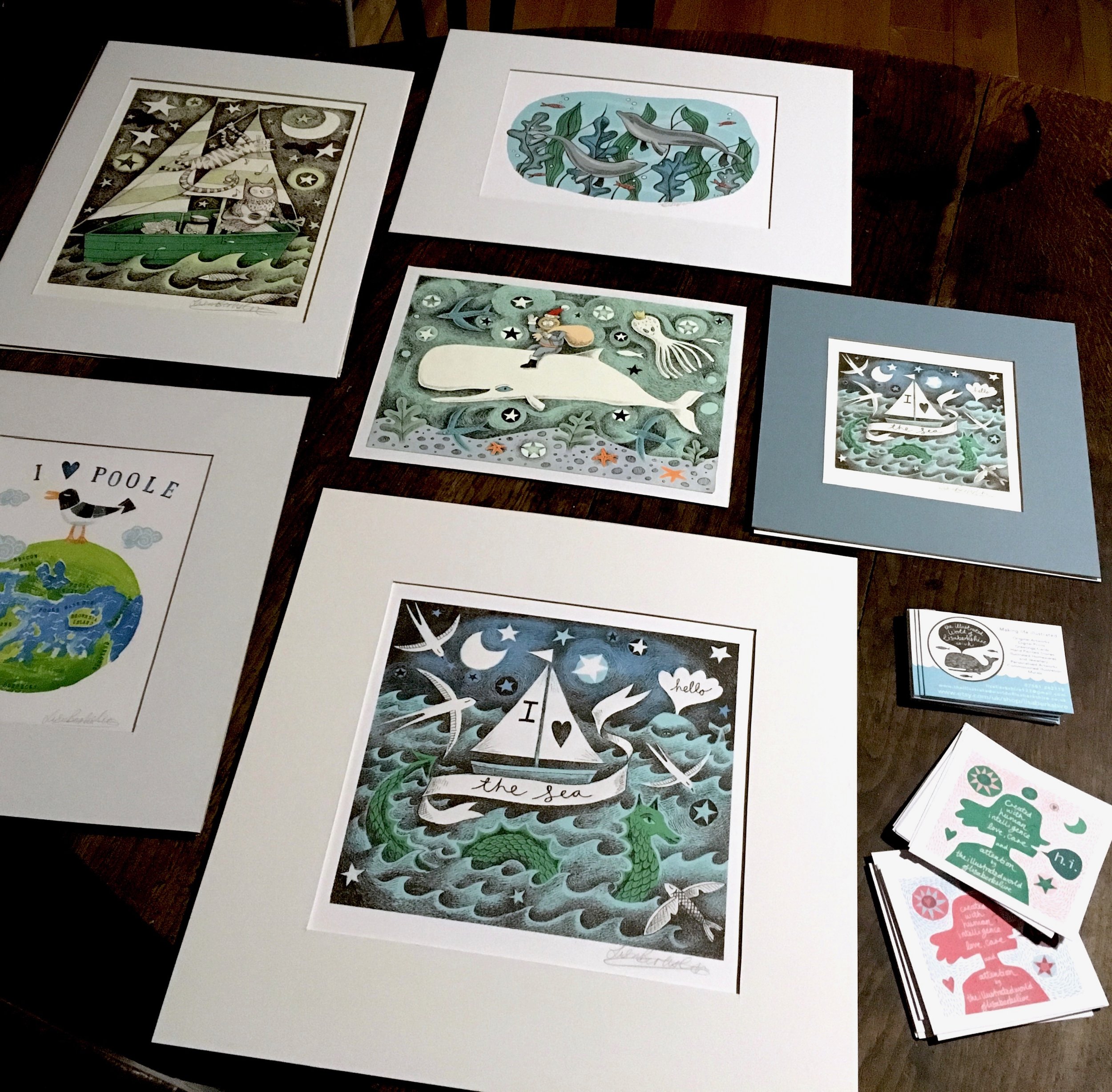Lisa Berkshire
By Kate Marsden
We’re off for an Easter trip to the seaside this week! If you like your illustrations to be nautical, you’re certainly in the right place as we take a look at the beautiful work created by Lisa Berkshire. Lisa has been working as an illustrator since the early 1990s, and has had to adapt with the times, and apply plenty of perseverance to succeed in her career. Read on to hear some of Lisa’s pearls of wisdom (and why it’s so important to get away from your desk!).
Tell us a little about you. What do you do?
I’m an illustrator who lives and works by the sea in Poole, Dorset, a place I really love. I create illustrated artworks for ranges of prints, cards, jewellery, stories and homewares as well as carrying out commissioned work for publishing and design. I also love to breathe life into all kinds of old objects by upcycling them in an illustrated way, and hand-paint stones that I have found out and about in Cornwall and Dorset.
Writing is also important to me and I try to incorporate my own words and stories into my work as much as possible. Main themes are of the sea, myths and folk lore, stories and personal narratives, Cornwall, animals and nature in general.
Above all I love creating work that connects with people and their lives
What does a typical day involve?
My typical day starts by dropping my 13 year old son off to school on the way to my morning job as a Teaching Assistant at a local junior school, which I finish at 12.30pm.
I then rush back home to have a bit of lunch and catch up emails, and follow by working at my desk on my art projects. This could range from building up stocks of my painted stones and upcycled objects or carrying out commissioned work, to creating designs for cards and prints or printing out my own digital prints and cards. Sometimes I work on mural projects too, so it is then a case of leaving work and dashing over to pick up my bigger paintbrushes and get up a ladder.
Other times I might go to a cafe to do some drawing or planning, as I love to get away from my desk sometimes as it helps clear my head, as does popping out for a swim or a ride on my bike. Often great places for having ideas!
I usually stop around 5.30pm to cook tea for the family and do those necessary chores, and then if I’m not going out or otherwise engaged, I settle down on the sofa with my laptop to either do some work or research, and organise resources for projects and commissions. I often do the drawing stage of my painted stones while I am watching (or rather, listening) to the TV.
Where do you work? What is your studio space like? What do you enjoy doing when you're not working?
My main work space is a small upstairs box room overlooking the railway line opposite my house. It’s a small space, which is good in one way as I am within an arm’s reach of everything I might need, but it also means things do get piled up a lot and I have to move things about when I am working on different projects! All in all, I find it works for me though and it is great to have a space that is just mine that no one else uses or moves things around in.
I have worked in studio spaces outside of my home in the distant past, but with a family it works much better to be at home now. Having my laptop means I can do work outside of my work room which helps get away from the mess sometimes!
When I’m not working I love to get out about in the fresh air, swimming and cycling, visiting new places and generally flexing my lungs and muscles, which I find as a great antidote to sitting down breathing far too shallowly when intensely creating. I also love watching my son play football, doing things with the family, visiting our caravan in St Ives Bay and generally seeing friends and family as much as I can.
What do you consider to be the main challenges facing designer makers at the moment?
Currently, one of the main challenges for an artist is connecting with folk who might want to invest in their work (or has that been always?). In the early nineties when I first became an illustrator, getting work mostly involved getting myself and my work directly in front of a client in the shape of interviews, or by direct sends; whereas now work can be easily put out there in front of millions of potential clients and customers at the touch of a button via social media and personal websites and online platforms.
The fact that it is so easy to create an online profile as an artist means there is a lot of competition, so it is vital to work hard on your own authentic ideas and work hard over time to create a consistent narrative that people can invest in. I think sticking to your own individual and authentic voice is the best way to make people notice you really.
What ambitions do you have for your business over the next few years?
I changed over from being a long term illustrator working on commissions for designers and publishers in all kinds of styles, to one who now spends most of my time creating my own ranges of artworks in my own signature style. The big thing for me now is to have a ball doing it, which I definitely am! I have big plans to create signature ranges of homewares and artworks, and am currently getting my first tea towel, mug and fabric designs professionally printed for launching late spring, early summer. My artistic motto is ‘Making Life Illustrated’, which is exactly what I’m trying to do.
I also hope to get interesting commissions to work on, as I love to work on new things in new directions, in my own way and style of course!
Getting my own stories out there and connecting with folk is also another main ambition, I have written a children’s novel and plan to get that into shape to publish in the next few years.
Do you have any tips for fellow designer makers/small business owners who are reading this and may be just starting out?
I think it is really important to play and explore, and get yourself really at one with your voice and why you want to do your art to start with, and above all to enjoy what you do. Being an artist requires huge amounts of self-belief, dedication and perseverance sometimes, so it really needs to be something you are totally invested in and enthusiastic about. Being flexible and adaptable is also important.
Creating specific plans to get dreams into reality is also essential. I have scaled down the amount of projects I want to achieve this year as I have, in the past, started too many projects at the same time, thus got side tracked from getting them all finished. I’m already feeling that a lot more is being achieved. It was of great help investing in the Design Trust’s Dream Plan Do planner in the new year, as it really gave me a good framework for all my crazy ideas. Having a plan and a structure to my time really helps me let loose creatively.
Please share any favourite independent shops/galleries and tell us why you like them.
Illustrated Living A gorgeous shop in Truro, Cornwall. I have a friend who lives in Truro and I visit every time I’m there, it’s illustration heaven.
Mostyn Gallery Llandudno A wonderful gallery on the North Coast of Wales, I have been working with them for about 3 years now with cards, prints, originals and other printed works selling there with them. They are a big supporter of the Just a Card campaign too.
Found Gallery Dunbar Lovely gallery full of indie makers on the East Coast of Scotland. I have some of my creations there, I have to just follow it online unfortunately but would love to visit. It seems to be part of a thriving high street up there.
Had you realised the Just A Card campaign message suggests cards as an example of a small purchase - we're about encouraging all sales as they keep businesses afloat?
Yes. Cards are a great symbol as they are often the smallest and cheapest item in a shop or gallery, and easy to buy, but any small purchase is just as important. Sometimes I regretfully realise I have spent money on something from a larger shop that really isn’t original or that good to give, but was easy at the time, which is a shame.
If we get into the regular habit of visiting shops that feature indie makers, we will get into the habit of investing in much more authentic gifts and purchases, which I think the recipients appreciate too. Lots of the small batch creations sold in galleries and shops that sell handmade are also printed and produced by other small indie businesses in the UK, so there are so many people you are supporting on our lovely creative isle by buying these handmade items.
How important is the Just A Card campaign message to you and your business?
It’s a great hook to start people talking about the issue, and to help customers realise that indie makers are part of an important movement that needs support. I don’t think people give much thought about where they buy things from sometimes, and that small makers are actually making their living at their art and need the support.
Where did you hear about the campaign and which Social Media platforms do you use most frequently? What do you think people can do to support Just A Card, and how will you be doing so?
I first heard of the Just a Card campaign on Twitter and Instagram. It has a great message and great visuals too, so is eye catching and made a lot of sense to me. I have printed out the flyers and posters and have them on my stall, as well as wearing my pin with pride. I also post about JAC campaign by using the hashtag and joining in the Twitter hour.








